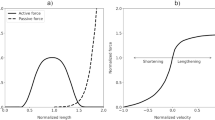Abstract
Today, to create and to simulate a virtual anatomical version of a subject is useful in the decision process of surgical treatments. The muscular activity is one of the factors which can contribute to abnormal movements such as in spasticity or static contracture. In this paper, we propose a numerical solution, based on the Finite Element (FE) method, able to estimate muscles deformations during contraction. Organized around a finite element solver and a volumetric environment, this solution is made of all the modeling and simulation processes from the discretization of the studied domain to the visualization of the results. The choices of materials and properties of the FE model are also presented such as the hyperelasticity, the contention model based on inter-meshes neighboring nodes pairing, and the estimation of nodal forces based on the subject-specific muscular forces and action lines.
Similar content being viewed by others
References
Code-Aster Platform: http://www.code-aster.org/
Salome Platform: http://www.salome-platform.org/
Ansari, M., Lee, S., Cho, C.: Hyperelastic muscle simulation. Key Eng. Mater. 345–346, 1241–1244 (2007)
Beillas, P., Begeman, P., Yang, K., King, A., Arnoux, P., Kang, H., Kayvantash, K., Brunet, C., Cavallero, C., Prasad, P.: Lower limb: advanced FE model and new experimental data. Stapp Car Crash J. 45, 469–494 (2001)
Belytschko, T., Chen, J.: Meshfree and Particle Methods. Wiley, New York (2007)
Belytschko, T., Liu, W., Moran, B.: Nonlinear Finite Elements for Continua and Structures. Wiley, New York (2006)
Blankevoort, L., Kuiper, J., Huiskes, R., Grootenboer, H.: Articular contact in a three-dimensional model of the knee. J. Biomech. 24(11), 1019–1031 (1991)
Buchler, P., Ramaniraka, N., Rakotomanana, L., Iannotti, J., Farron, A.: A finite element model of the shoulder: application to the comparison of normal and osteoarthritic joints. Clin. Biomech. 17, 630–639 (2002)
Crisfield, M.: Non-Linear Finite Element Analysis of Solids and Structures, vols. 1–2 (1997)
Delp, S., Loan, J., Hoy, M., Zajac, F., Topp, E., Rosen, J.: An interactive graphics-based model of the lower extremity to study orthopaedic surgical procedures. IEEE Trans. Biomed. Eng. 37(8), 757–767 (1990)
Donzelli, P., Spilker, R., Ateshian, G., Mow, V.: Contact analysis of biphasic transversely isotropic cartilage layers and correlations with tissue failure. J. Biomech. 32(10), 1037–1047 (1999)
Hirokawa, S., Tsuruno, R.: Hyper-elastic model analysis of anterior cruciate ligament. Med. Eng. Phys. 19(7), 637–651 (1997)
James, D., Pai, D.: Dyrt: Dynamic response textures for real time deformation simulation with graphics hardware. ACM Trans. Graph. (SIGGRAPH Proc.) 21 (2002)
Jonkers, I., Spaepen, A., Papaioannou, G., Steward, C.: Contribution of forward simulation techniques to the understanding of muscle activation patterns in mid-stance phase of gait. J. Biomech. 35(5), 609–619 (2002)
Keyak, J., Skinner, H.: Three-dimensional finite element modelling of bone: effects of element size. J. Biomed. Eng. 14(6), 483–489 (1992)
Mac Donald, B.: Practical Stress Analysis with Finite Elements. Glasnevin Publishing (2007)
Macosko, C.: Rheology: Principles, Measurements, and Applications. VCH, New York (1994)
Mow, V., Flatow, E., Ateshian, G.: Biomechanics. In: Buckwalter, J.A., Einhorn, T.A., Simon, S.R. (eds.) Orthopaedic Basic Science: Biology and Biomechanics of the Musculoskeletal System, 2nd edn. pp. 133–181. American Academy of Orthopaedic Surgeons, USA (2000)
Muller, M., Dorsey, J., McMillan, L., Jagnow, R., Cutler, B.: Stable real-time deformations. In: Proceedings of the ACM SIGGRAPH Symposium on Computer Animation, pp. 49–54. ACM, New York (2002)
Muller, M., McMillan, L., Dorsey, J., Jagnow, R.: Real-time simulation of deformation and fracture of stiff materials. In: Computer Animation and Simulation ’01, Eurographics Workshop, pp. 99–111. Eurographics Assoc. (2001)
Papaioannou, G., Nianios, G., Mitrogiannis, C., Fyhrie, D., Tashman, S., Yang, K.: Patient-specific knee joint finite element model validation with high-accuracy kinematics from biplane dynamic roentgen stereogrammetric analysis. J. Biomech. 41(12), 2633–2638 (2008)
Scheepers, F., Parent, R., Carlson, W., May, S.: Anatomy-based modeling of the human musculature. In: SIGGRAPH ’97: Proceedings of the 24th Annual Conference on Computer Graphics and Interactive Techniques, pp. 163–172 (1997)
Schmid, J., Sandholm, A., Chung, F., Thalmann, D., Delingette, H., Magnenat-Thalmann, N.: Musculoskeletal simulation model generation from MRI data sets and motion capture data. The Visual Computer (2009)
Sederberg, T., Parry, S.: Free-form deformations of solid geometric models. Comput. Graph. (SIGGRAPH Proc.) pp. 151–160 (1986)
Tang, C., Tsui, C., Stojanovic, B., Kojic, M.: Finite element modelling of skeletal muscles coupled with fatigue. Int. J. Mech. Sci. 49(10), 1179–1191 (2007)
Thalmann, D., Jianhua, S., Chauvineau, E.: Fast realistic human body deformations for animation and VR applications. In: Proceedings. Computer Graphics International. IEEE Comput. Soc. Press (1996)
Winters, J.: Hill-based muscle models: A systems engineering perspective. In: Winters, J.M., Woo, S.L.-Y. (eds.) Multiple Muscle Systems: Biomechanics and Movement Organization, pp. 69–93. Springer, Berlin (1990)
Author information
Authors and Affiliations
Corresponding author
Rights and permissions
About this article
Cite this article
Maurice, X., Sandholm, A., Pronost, N. et al. A subject-specific software solution for the modeling and the visualization of muscles deformations. Vis Comput 25, 835–842 (2009). https://doi.org/10.1007/s00371-009-0313-9
Published:
Issue Date:
DOI: https://doi.org/10.1007/s00371-009-0313-9




